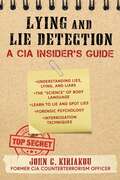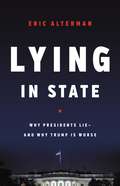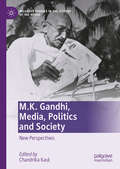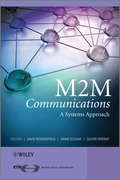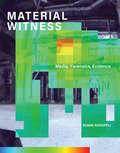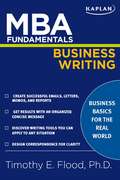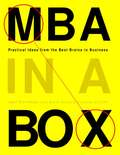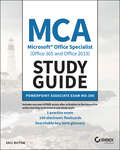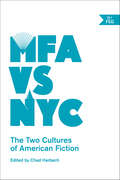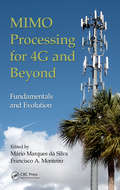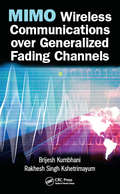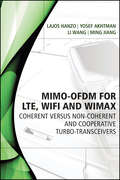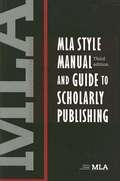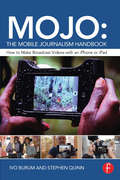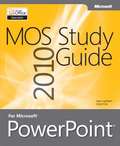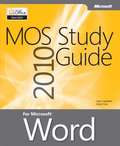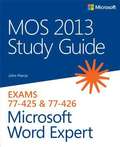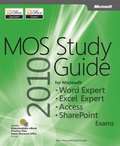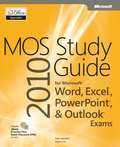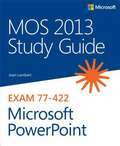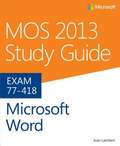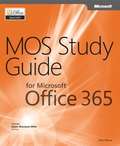- Table View
- List View
Lying and Lie Detection: A CIA Insider's Guide
by John KiriakouA foolproof guide both to lying and to detecting deception,Lying and Lie Detection: A CIA Insider's Guide will teach you how the pros can tell if and when somebody is lying. People lie all the time. Studies show that the average American lies between six and twenty times a day. Most lies are of the &“little white&” variety or are meant to spare a person&’s feelings. But what about the big lies? What about the consequential ones? You have a right to know when somebody is lying to you. Now, imagine if you had the tools to spot a lie from the truth—a guide to perfect your sixth sense. Whether it's finding out if you truly got the job, unmasking an infidelity, or a simple recommendation, you will no longer have to spend hours, days, or even weeks pondering about it. Through the easy-to-follow instructions and professional anecdotes in Lying and Lie Detection: A CIA Insider's Guide, you&’ll learn to lie and spot lies from John Kiriakou, a former CIA counterterrorism officer and senior investigator for the Senate Foreign Relations Committee responsible for the capture of Abu Zubaydah.Remember, CIA operations officers are trained to lie. They lie all the time. When they are working undercover, they are actually living a lie. With the CIA as a teacher, you&’ll learn how to tell.
Lying in State: Why Presidents Lie -- And Why Trump Is Worse
by Eric AltermanThis definitive history of presidential lying reveals how our standards for truthfulness have eroded -- and why Trump's lies are especially dangerous.If there's one thing we know about Donald Trump, it's that he lies. But he's by no means the first president to do so. In Lying in State, Eric Alterman asks how we ended up with such a pathologically dishonest commander in chief, showing that, from early on, the United States has persistently expanded its power and hegemony on the basis of presidential lies. He also reveals the cumulative effect of this deception-each lie a president tells makes it more acceptable for subsequent presidents to lie-and the media's complicity in spreading misinformation. Donald Trump, then, represents not an aberration but the culmination of an age-old trend. Full of vivid historical examples and trenchant analysis, Lying in State is essential reading for anyone seeking to understand how we arrived in this age of alternative facts.
Lynzsea Sky: An American True Story
by Michael RozekLynzsea Sky, a twenty-something college student, tells the author her heartbreaking, disturbing, and culture-challenging life story. She speaks at first hesitantly, then with increasing clarity about sex, drugs, family life, education, tattoos, homelessness, her dreams of becoming a filmmaker, her brother's time in prison, and her mother's struggle with mental illness.<P><P>The book is just the conversation; the absence of anything else makes this a groundbreaking new form of nonfiction. The lean prose is void of stylistic hijinks, drawing the reader in without drawing attention to the writer.The author's first book is part of a planned series called American True Stories, all of which will be similarly dialogue based. Michael Rozek's work illuminates real American lives and gives a voice to people who often are overlooked by the mainstream media.Michael Rozek has written more than two thousand articles for various national magazines including Rolling Stone, Esquire, Sports Illustrated, and The Village Voice in a career spanning nearly forty years. He walked away from a lucrative free-lance career to publish the popular Rozek's Newsletter in the 1990s in response to the "fast food" journalism he saw increasingly creeping into American magazines. For more than a decade, Rozek and his wife Charlotte have struggled with homelessness and poverty, yet Rozek continues to talk to and write about everyday Americans with empathy and insight. This is his first book.
M.K. Gandhi, Media, Politics and Society: New Perspectives (Palgrave Studies in the History of the Media)
by Chandrika KaulThis Palgrave Pivot showcases new research on M.K. Gandhi or Mahatma Gandhi, and the press, telegraphs, broadcasting and popular culture. Despite Gandhi being the subject of numerous books over the past century, there are few that put media centre stage. This edited collection explores both Gandhi’s own approach to the press, but also how different advocacy groups and the media, within India and overseas, engaged with Gandhi, his ideology and methodology, to further their own causes. The timeframe of the book extends from the late nineteenth century up to the present, and the case studies draw inspiration from a number of disciplinary approaches.
M2M Communications
by Olivier Hersent Omar Elloumi David BoswarthickA comprehensive introduction to M2M Standards and systems architecture, from concept to implementationFocusing on the latest technological developments, M2M Communications: A Systems Approach is an advanced introduction to this important and rapidly evolving topic. It provides a systems perspective on machine-to-machine services and the major telecommunications relevant technologies. It provides a focus on the latest standards currently in progress by ETSI and 3GPP, the leading standards entities in telecommunication networks and solutions. The structure of the book is inspired by ongoing standards developments and uses a systems-based approach for describing the problems which may be encountered when considering M2M, as well as offering proposed solutions from the latest developments in industry and standardization.The authors provide comprehensive technical information on M2M architecture, protocols and applications, especially examining M2M service architecture, access and core network optimizations, and M2M area networks technologies. It also considers dominant M2M application domains such as Smart Metering, Smart Grid, and eHealth. Aimed as an advanced introduction to this complex technical field, the book will provide an essential end-to-end overview of M2M for professionals working in the industry and advanced students.Key features:First technical book emerging from a standards perspective to respond to this highly specific technology/business segmentCovers the main challenges facing the M2M industry today, and proposes early roll-out scenarios and potential optimization solutionsExamines the system level architecture and clearly defines the methodology and interfaces to be consideredIncludes important information presented in a logical manner essential for any engineer or business manager involved in the field of M2M and Internet of ThingsProvides a cross-over between vertical and horizontal M2M concepts and a possible evolution path between the twoWritten by experts involved at the cutting edge of M2M developments
M: Marketing
by Dhruv Grewal Michael LevyM: Marketing is the most concise, impactful approach to Principles of Marketing on the market, with tightly integrated topics that explore both marketing fundamentals and new influencers, all in an engaging format. Authors Grewal and Levy emphasize that even the best products and services will go unsold if marketers cannot communicate their value. A robust suite of instructor resources and a regularly updated author blog provide a steady stream of current, fresh ideas for the classroom. Grewal and Levy's M: Marketing, Sixth Edition, is available through McGraw-Hill Connect®, a highly reliable, easy-to-use homework and learning management solution that embeds learning science and award-winning adaptive tools to improve student results.
MATERIAL WITNESS: Media, Forensics, Evidence (Leonardo)
by Susan SchuppliThe evidential role of matter—when media records trace evidence of violence—explored through a series of cases drawn from Kosovo, Japan, Vietnam, and elsewhere.In this book, Susan Schuppli introduces a new operative concept: material witness, an exploration of the evidential role of matter as both registering external events and exposing the practices and procedures that enable matter to bear witness. Organized in the format of a trial, Material Witness moves through a series of cases that provide insight into the ways in which materials become contested agents of dispute around which stake holders gather.These cases include an extraordinary videotape documenting the massacre at Izbica, Kosovo, used as war crimes evidence against Slobodan Milošević; the telephonic transmission of an iconic photograph of a South Vietnamese girl fleeing an accidental napalm attack; radioactive contamination discovered in Canada's coastal waters five years after the accident at Fukushima Daiichi; and the ecological media or “disaster film” produced by the Deep Water Horizon oil spill in the Gulf of Mexico. Each highlights the degree to which a rearrangement of matter exposes the contingency of witnessing, raising questions about what can be known in relationship to that which is seen or sensed, about who or what is able to bestow meaning onto things, and about whose stories will be heeded or dismissed.An artist-researcher, Schuppli offers an analysis that merges her creative sensibility with a forensic imagination rich in technical detail. Her goal is to relink the material world and its affordances with the aesthetic, the juridical, and the political.
MBA Fundamentals Business Writing
by Timothy E. FloodNeed to summarize a meeting for your boss? Send an email that alerts the recipient to a change in plans? Formally respond to a customer's query? The way you word, format, and transmit business correspondence directly affects the results you'll get. This handy guide provides thorough, straightforward guidance on the writing issues you frequently encounter. You'll learn all of the business writing basics, including: How to organize your writing for maximum efficiency Essential guidelines for enacting a professional tone and presence Helpful strategies for ensuring proper use of punctuation and grammar Practical techniques for the layout of your text and embedded visual objects Best practices for print and electronic communications, including memos, letters, reports, and emails
MBA in a Box: Practical Ideas from the Best Brains in Business
by Joel Kurtzman Glenn Rifkind Victoria GriffithThe best minds in business—at your serviceMBA in a Box brings together some of the best brains in business who show how the core curriculum of an MBA program works in the real world. People like Michael Porter, Rosabeth Moss Kanter, Adrian J. Slywotzky, Warren Bennis, and Bill George give you a box full of ideas and tools that can boost your career and help you add value to your organization. For example: • Why finance is not just about manipulating numbers but of immense importance in sustaining growth, building widespread wealth, and creating jobs. • The profit zone and how to tell if a business is in one. • The skill of turning an idea or invention into a product that solves a problem for a market. • Merging the need of business to produce and grow with the environment so they are both sustained. • The latest thinking in marketing about branding, pricing, reversing a product’s life cycle, and turning what has become a commodity into a specialty.• And much more.
MCA Microsoft Office Specialist (Office 365 and Office 2019) Study Guide: PowerPoint Associate Exam MO-300
by Eric ButowMCA Microsoft Office Specialist Study Guide: PowerPoint Associate Exam MO-300 is your roadmap to preparing for taking the MO-300 exam and earning the PowerPoint Associate (PowerPoint and PowerPoint 2019) certification. The following objectives are covered: Manage presentations Manage slides Insert and format text, shapes, and images Insert tables, charts, smartArt, 3D models, and media Apply transitions and animations Major topics include creating, editing, and enhancing presentations and slideshows, including the ability to create and manage presentations, insert and format shapes and slides, create slide content, apply transitions and animations, and manage multiple presentations. This Study Guide also covers creating professional-grade sales presentations, employee training, instructional materials, and kiosk slideshows.Readers will also have access to Sybex's superior online test bank, includng hundreds of practice questions, flashcards, and a glossary of important terms.
MFA vs NYC: The Two Cultures of American Fiction
by Chad HarbachWriters write—but what do they do for money?In a widely read essay entitled "MFA vs NYC," bestselling novelist Chad Harbach (The Art of Fielding) argued that the American literary scene has split into two cultures: New York publishing versus university MFA programs. This book brings together established writers, MFA professors and students, and New York editors, publicists, and agents to talk about these overlapping worlds, and the ways writers make (or fail to make) a living within them. Should you seek an advanced degree, or will workshops smother your style? Do you need to move to New York, or will the high cost of living undo you? What's worse—having a day job or not having health insurance? How do agents decide what to represent? Will Big Publishing survive? How has the rise of MFA programs affected American fiction? The expert contributors, including George Saunders, Elif Batuman, and Fredric Jameson, consider all these questions and more, with humor and rigor. MFA vs NYC is a must-read for aspiring writers, and for anyone interested in the present and future of American letters.
MIMO Antennas for Wireless Communication: Theory and Design
by Leeladhar Malviya Rajib Kumar Panigrahi M.V. KartikeyanThe desired objective of this book is to investigate diversity and mutual coupling effects on MIMO antenna designs for WLAN/WiMAX/LTE applications, controlled with diversity and ground modification techniques including equivalent circuit diagrams. Diversity techniques in MIMO antennas leading to the performance improvement ratings are demonstrated and deliberated. The book contributes towards the development of 2:1 VSWR MIMO antennas with diversity techniques for indoor/outdoor applications for high data rate, QOS, and SNR. The improved MIMO antenna structures are investigated and presented in this book including part of massive MIMO to provide the important aspects of emerging technology. Aimed at researchers, professionals and graduate students in electrical engineering, electromagnetics, communications and signal processing including antenna theory and design, smart antennas, communication systems, this book: Investigates real time MIMO antenna designs for WLAN/WiMAX/LTE applications. Covers effects of ECC, MEG, TARC, and equivalent circuit. Addresses the coupling and diversity aspects of antenna design problem for MIMO systems. Focus on the MIMO antenna designs for the real time applications. Exclusive chapter on 5G Massive MIMO along with case studies throughout the book.
MIMO Processing for 4G and Beyond: Fundamentals and Evolution
by Mário Marques da Silva Francisco A. MonteiroMIMO Processing for 4G and Beyond: Fundamentals and Evolution offers a cutting-edge look at multiple-input multiple-output (MIMO) signal processing, namely its detection (in both time and frequency domains) and precoding. It examines its integration with OFDM, UWB, and CDMA, along with the impact of these combinations at the system level. Massive M
MIMO Wireless Communications over Generalized Fading Channels
by Brijesh Kumbhani Rakhesh Singh KshetrimayumMIMO systems have been known to better the quality of service for wireless communication systems. This book discusses emerging techniques in MIMO systems to reduce complexities and keep benefits unaffected at the same time. It discusses about benefits and shortcomings of various MIMO technologies like spatial multiplexing, space time coding, spatial modulation, transmit antenna selection and various power allocation schemes to optimize the performance. Crux of the book is focus on MIMO communication over generalized fading channels as they can model the propagation of signals in a non-homogeneous environment. Relevant MATLAB codes are also included in the appendices. Book is aimed at graduate students and researchers in electronics and wireless engineering specifically interested in electromagnetic theory, antennas and propagation, future wireless systems, signal processing.
MIMO-OFDM for LTE, WiFi and WiMAX: Coherent versus Non-coherent and Cooperative Turbo Transceivers (Wiley - IEEE #26)
by Yosef Akhtman Ming Jiang Li Wang Lajos HanzoMIMO-OFDM for LTE, WIFI and WIMAX: Coherent versus Non-Coherent and Cooperative Turbo-Transceivers provides an up-to-date portrayal of wireless transmission based on OFDM techniques augmented with Space-Time Block Codes (STBCs) and Spatial-Division Multiple Access (SDMA). The volume also offers an in-depth treatment of cutting-edge Cooperative Communications. This monograph collates the latest techniques in a number of specific design areas of turbo-detected MIMO-OFDM wireless systems. As a result a wide range of topical subjects are examined, including channel coding and multiuser detection (MUD), with a special emphasis on optimum maximum-likelihood (ML) MUDs, reduced-complexity genetic algorithm aided near-ML MUDs and sphere detection. The benefits of spreading codes as well as joint iterative channel and data estimation are only a few of the radical new features of the book. Also considered are the benefits of turbo and LDPC channel coding, the entire suite of known joint coding and modulation schemes, space-time coding as well as SDM/SDMA MIMOs within the context of various application examples. The book systematically converts the lessons of Shannon's information theory into design principles applicable to practical wireless systems; the depth of discussions increases towards the end of the book. Discusses many state-of-the-art topics important to today's wireless communications engineers. Includes numerous complete system design examples for the industrial practitioner. Offers a detailed portrayal of sphere detection. Based on over twenty years of research into OFDM in the context of various applications, subsequently presenting comprehensive bibliographies.
MLA Style Manual and Guide to Scholarly Publishing (3rd Edition)
by The Modern Language Association of AmericaA complete, up-to-date guide for writing scholarly texts, documenting research sources, submitting manuscripts to publishers, and dealing with legal issues surrounding publication.
MOJO: How to Make Broadcast Videos with an iPhone or iPad
by Stephen Quinn Ivo BurumMOJO: The Mobile Journalism Handbook is the first book devoted specifically to training citizens, journalism students and media professionals to produce professional-quality videos with only a mobile device. As journalism becomes increasingly competitive, students and emerging professionals need a broader skillset to make themselves more employable, whether as mainstream or entrepreneurial journalists. This book by Dr. Ivo Burum and Dr. Stephen Quinn, world experts in mobile journalism, provides comprehensive coverage of all the skills and practices needed to be a mobile journalist. Key features: Burum and Quinn underline the importance of story and storytelling, the crucial context journalists always need to keep in mind. Other books and tutorials merely offer step-by-step guidance to mobile technology and apps. The book synthesizes the knowledge and more than 70 years of combined expertise of two of the world’s leading mobile journalism practitioners, offering sage advice and tips from people who have trained mojos in more than 20 countries. Companion Website: How-to videos on the companion website offer powerful ways for learners to absorb the content easily, walking them through the key mojo components of research, shooting, scripting, voice-over, editing and post-production. www.routledge.com/cw/burum Ivo Burum is an award-winning writer, director and television executive producer. He has more than 30 years’ experience working across genres including frontline international current affairs. A pioneer in UGS creation, Dr. Burum lectures in multimedia journalism. This is his second book about mojo. He runs Burum Media, a mojo and web TV consultancy that provides training for journalists, educators and remote communities internationally. Stephen Quinn was a journalist for 20 years before he became a university professor in 1996. Dr. Quinn taught journalism in five countries until he returned to journalism in 2011 in Hong Kong. His UK-based company MOJO Media Insights trains mobile journalists around the world. This is his twenty-first print book. He has also produced 5 iBooks. He co-writes a weekly column syndicated to seven countries.
MOS 2010 Study Guide for Microsoft® PowerPoint®
by Joan Lambert Joyce CoxDemonstrate your expertise with Microsoft PowerPoint by earning a MOS 2010 certification. This Study Guide is designed to help you practice and prepare for Exam 77-883: PowerPoint 2010, and features: Full objective-by-objective review Procedures and hands-on practice tasks Ready-made, downloadable practice files Exam-discount Use the in-depth exam prep, practice, and review to help advance your proficiency with PowerPoint 2010--and earn the credential that proves it! NOTE: This same content is also available as part of the MOS 2010 Study Guide for Microsoft Word, Excel, PowerPoint, and Outlook Exams (ISBN 9780735648753)
MOS 2010 Study Guide for Microsoft® Word
by Joan Lambert Joyce CoxDemonstrate your expertise with Microsoft Word by earning a MOS 2010 certification. This Study Guide is designed to help you practice and prepare for Exam 77-881: Word 2010, and features:Full objective-by-objective review Procedures and hands-on practice tasks Ready-made, downloadable practice files Exam-discount Use the in-depth exam prep, practice, and review to help advance your proficiency with Word 2010--and earn the credential that proves it! NOTE: This same content is also available as part of the MOS 2010 Study Guide for Microsoft Word, Excel, PowerPoint, and Outlook Exams (ISBN 9780735648753)
MOS 2010 Study Guide for Microsoft® Word Expert
by John PierceDemonstrate your expertise with Microsoft Word by earning a MOS 2010 certification. This Study Guide is designed to help you practice and prepare for Exam 77-887: Word 2010 Expert, and features:Full objective-by-objective review Procedures and hands-on practice tasks Ready-made, downloadable practice files Exam-discount Use the in-depth exam prep, practice, and review to help further advance your proficiency with Word 2010--and earn the expert-level credential that proves it! NOTE: This same content is also available as part of the MOS 2010 Study Guide for Microsoft Word Expert, Excel Expert, Access, & SharePoint Exams (ISBN 9780735657885)
MOS 2010 Study Guide for Microsoft® Word Expert, Excel® Expert, Access®, and SharePoint®
by John Pierce Geoff EvelynDemonstrate your expertise with Microsoft Office! Designed to help you practice and prepare for four Microsoft Office Specialist (MOS) exams, this all-in-one study guide features: Full, objective-by-objective exam coverage Easy-to-follow procedures and illustrations to review essential skills Hands-on practice tasks to apply what you've learned; files included Online pre-test to assess your readiness Use the in-depth exam prep, practice, and review to help advance your proficiency with Microsoft Office--and earn the credential that proves it! Exams covered: 77-887: MOS: Microsoft Office Word 2010 Expert 77-888: MOS: Microsoft Office Excel 2010 Expert 77-885: MOS: Microsoft Office Access 2010 77-886: MOS: Microsoft SharePoint 2010 Companion Content includes: Practice files for each exam Fully searchable eBook Sample chapters from five STEP BY STEP books from Microsoft Press (TBD) Additional eBooks and resources Special Offer: Exam discount plus free online pre-test! Get 25% off your MOS exam fee and a free Microsoft Official Pre-Test from Certiport Use the pre-test to assess your skill level and get feedback on your results, including a custom learning plan See details on the Certiport offer page inside
MOS 2010 Study Guide for Microsoft® Word, Excel®, PowerPoint®, and Outlook®
by Joan Lambert Joyce CoxDemonstrate your expertise with Microsoft Office 2010! This all-in-one guide is designed to help you practice and prepare for the four core Microsoft Office Specialist (MOS) exams. With the MOS 2010 Study Guide, you get full, objective-by-objective coverage for: Exam 77-881: Microsoft Word 2010 Exam 77-882: Microsoft Excel 2010 Exam 77-883: Microsoft PowerPoint 2010 Exam 77-884: Microsoft Outlook 2010 Use the book's easy-to-follow procedures and illustrations to review the essential skills measured by the MOS exams. And you can apply what you've learned hands-on--using the downloadable files for all the book's practice tasks.
MOS 2013 Study Guide for Microsoft PowerPoint
by Joan LambertDemonstrate your expertise with Microsoft Office! Designed to help you practice and prepare for the 2013 PowerPoint Microsoft Office Specialist (MOS) exam, this all-in-one study guide features: Full, objective-by-objective exam coverage Easy-to-follow procedures and illustrations to review essential skills Hands-on practice tasks to apply what you've learned; files included Use the in-depth exam prep, practice, and review to help advance your proficiency with Microsoft Office--and earn the credential that proves it!
MOS 2013 Study Guide for Microsoft Word
by Joan LambertDemonstrate your expertise with Microsoft Office! Designed to help you practice and prepare for the 2013 Word Microsoft Office Specialist (MOS) exam, this all-in-one study guide features: Full, objective-by-objective exam coverage Easy-to-follow procedures and illustrations to review essential skills Hands-on practice tasks to apply what you've learned; files included Use the in-depth exam prep, practice, and review to help advance your proficiency with Microsoft Office--and earn the credential that proves it!
MOS Study Guide for Microsoft® Office 365
by John PierceDemonstrate your expertise with Microsoft Office 365 by earning a MOS certification. This Study Guide is designed to help you prepare for MOS Exam 77-891: Microsoft Office 365, and features:Full objective-by-objective review Easy-to-follow procedures and hands-on tasks Exam-discount offer from Certiport Use the in-depth exam prep, practice, and review to help advance your proficiency with Office 365--and earn the credential that proves it.
